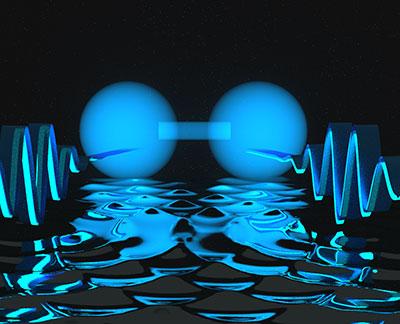‘Molecules’ made of light may be the basis of future computers
September 11, 2015

Researchers show that two photons, depicted in this artist’s conception as waves (left and right), can be locked together at a short distance. Under certain conditions, the photons can form a state resembling a two-atom molecule, represented as the blue dumbbell shape at center. (credit: E. Edwards/JQI)
Photons could travel side by side a specific distance from each other — similar to how two hydrogen atoms sit next to each other in a hydrogen molecule — theoretical physicists from the National Institute of Standards and Technology (NIST) and the University of Maryland (with other collaborators) have shown.
“It’s not a molecule per se, but you can imagine it as having a similar kind of structure,” says NIST’s Alexey Gorshkov. “We’re learning how to build complex states of light that, in turn, can be built into more complex objects. This is the first time anyone has shown how to bind two photons a finite distance apart.
“Lots of modern technologies are based on light, from communication technology to high-definition imaging,” Gorshkov says. “Many of them would be greatly improved if we could engineer interactions between photons.”
For example, the research could lead to new photonic computing systems, replacing slow electrons with light and reducing energy loses in the conversion from electrons to light and back.
“The detailed understanding of the [physics] also opens up an avenue towards understanding the full and much richer many-body problem involving an arbitrary number of photons in any dimension,” the authors state in a paper forthcoming in Physical Review Letters.
The findings build on previous research that several team members contributed to before joining NIST. In 2013, collaborators from Harvard, Caltech and MIT found a way to bind two photons together so that one would sit right atop the other, superimposed as they travel.
Abstract of Coulomb bound states of strongly interacting photons
We show that two photons coupled to Rydberg states via electromagnetically induced transparency can interact via an effective Coulomb potential. This interaction gives rise to a continuum of two-body bound states. Within the continuum, metastable bound states are distinguished in analogy with quasi-bound states tunneling through a potential barrier. We find multiple branches of metastable bound states whose energy spectrum is governed by the Coulomb potential, thus obtaining a photonic analogue of the hydrogen atom. Under certain conditions, the wavefunction resembles that of a diatomic molecule in which the two polaritons are separated by a finite “bond length.” These states propagate with a negative group velocity in the medium, allowing for a simple preparation and detection scheme, before they slowly decay to pairs of bound Rydberg atoms.